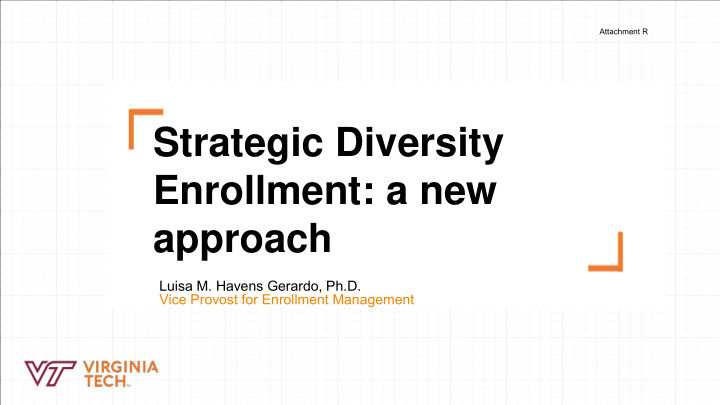



Attachment R Strategic Diversity Enrollment: a new approach Luisa M. Havens Gerardo, Ph.D. Vice Provost for Enrollment Management
Attachment R Early ID of Talent Identify high value prospects as early as 8 th grade Integrated Clear strategic segmentation of target populations and goals as early as 8 th grade recruitment plan Enhanced Approach Introduction of Non-Cognitive variables in the admissions review to Admissions process Review Financial Aid Optimize financial aid packages to promote enrollment and Leveraging Model student success • Evaluate pre-entry characteristics that contribute to student Contribute to the success metrics (retention, progression and on-time graduation) 360 approach to and optimize support and service delivery models to manage the student success entire student lifecycle.
Attachment R Early Identification of Talent • Partner with the micro-scholarship platform Raise.me to facilitate and reward activities and behaviors that promote college-going culture and create affinity with Virginia Tech early. • Create and deploy an integrated communication plan that targets students, families and other influencers. • Enhance our alumni recruitment network, to expand our presence at key undergraduate recruitment events and opportunities, create a prospect referral portal to promote alumni involvement in early identification of talent and coordinate more alumni send off events in key markets
Attachment R Integrated Recruitment Plan • Institutionalize the science of recruitment: -Use of data to drive strategic direction -Use of data to guide planning -Use of data to guide individual actions and territory management plans • Segment Analysis Service: allows us to use 150+ variables in 62 geodemographic clusters to identify and reach high value prospects in over 33,000 high-school and over 44,000 neighborhood in the U.S. • By reaching students of diverse academic, socioeconomic, and student-interest attributes, we will be able to build a strategic recruitment plan.
Attachment R Why an enhanced approach to admission review? • Non-cognitive assessments allow institutions to provide a tool for evaluating students that may not have had the same opportunities as others. • We do not need to completely eliminate grades and tests from our admissions systems; we need to add new measures that expand the range of dimensions we consider. • A number of non-cognitive variables have been useful in predicting the success of first- generation students, underrepresented minorities, marginalized populations, international students, LGBTQ students, older-than-average students or veterans and women in higher education at a variety of institutions and programs. • Cognitive variables assesses include self-concept, realistic self-appraisal, working the system (handling discrimination/racism), long-term goals, leadership, having a strong support person and community, and nontraditional learning.
Attachment R Financial Aid Leveraging Strategy Develop an econometrics model to inform a strategic financial aid leveraging plan. The plan will accomplish four main objectives: • Determine the appropriate amount of aid to promote increased enrollment of strategic populations • Directly contribute to the achievement of retention and graduation goals of different segments in the new and returning student population • Optimize the distribution of aid to serve more students • Balance attainment of enrollment goals with net tuition revenue goals and tuition discounting caps.
Attachment R Financial Aid Leveraging Strategy
Attachment R 360 approach to student success
Attachment R Strategic Diversity Enrollment: a new approach Luisa M. Havens Gerardo, Ph.D. Vice Provost for Enrollment Management
Recommend
More recommend